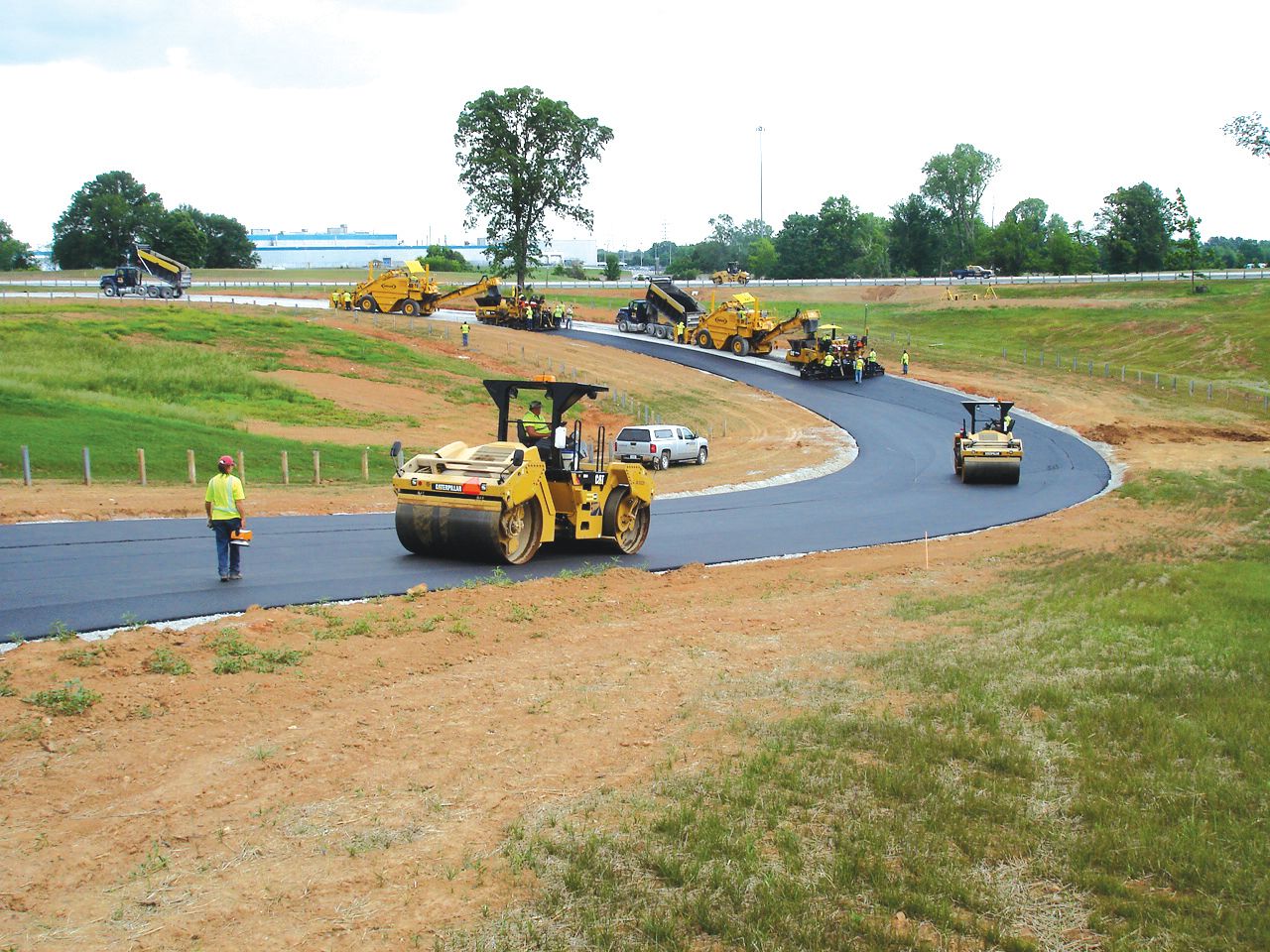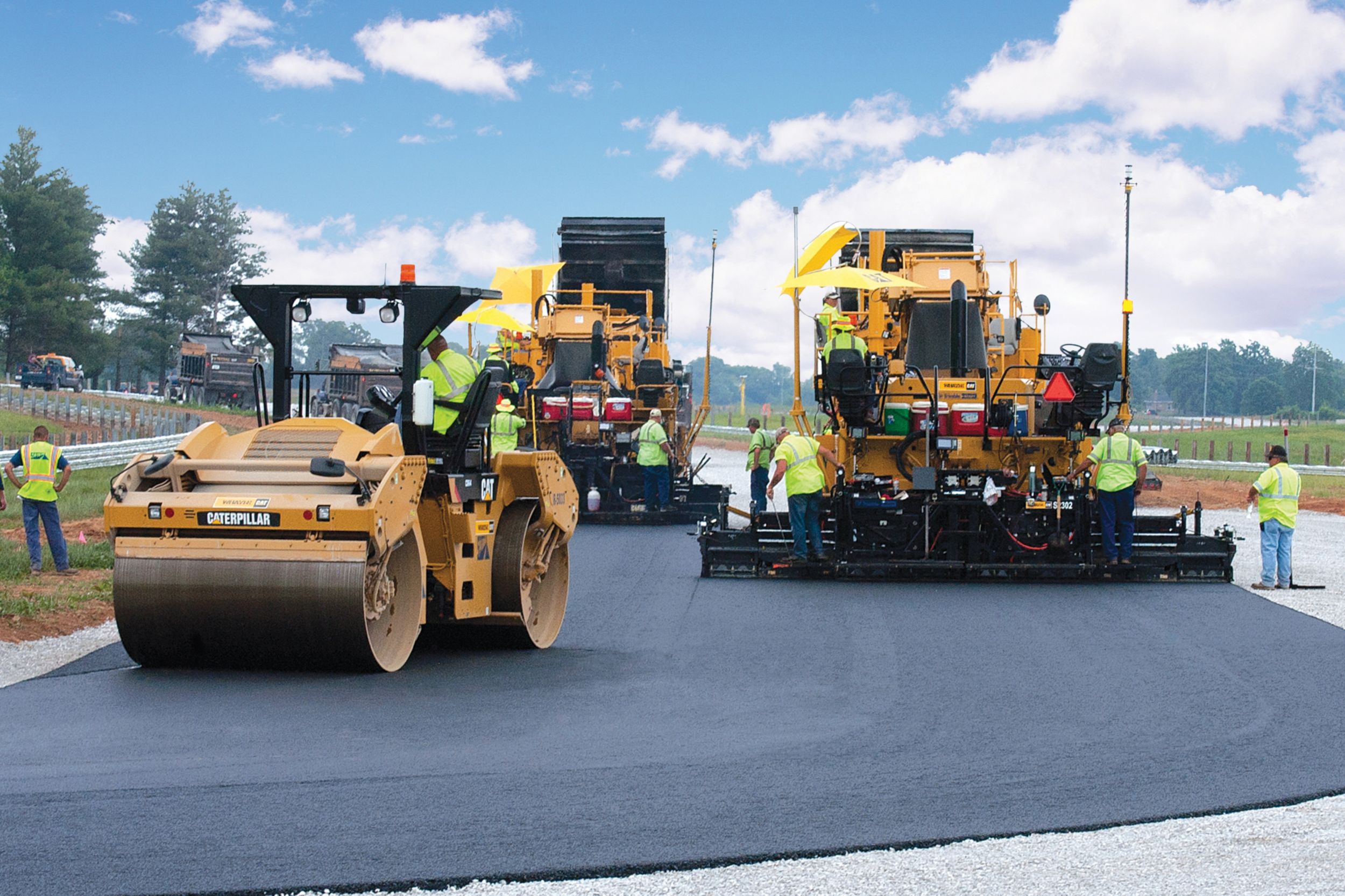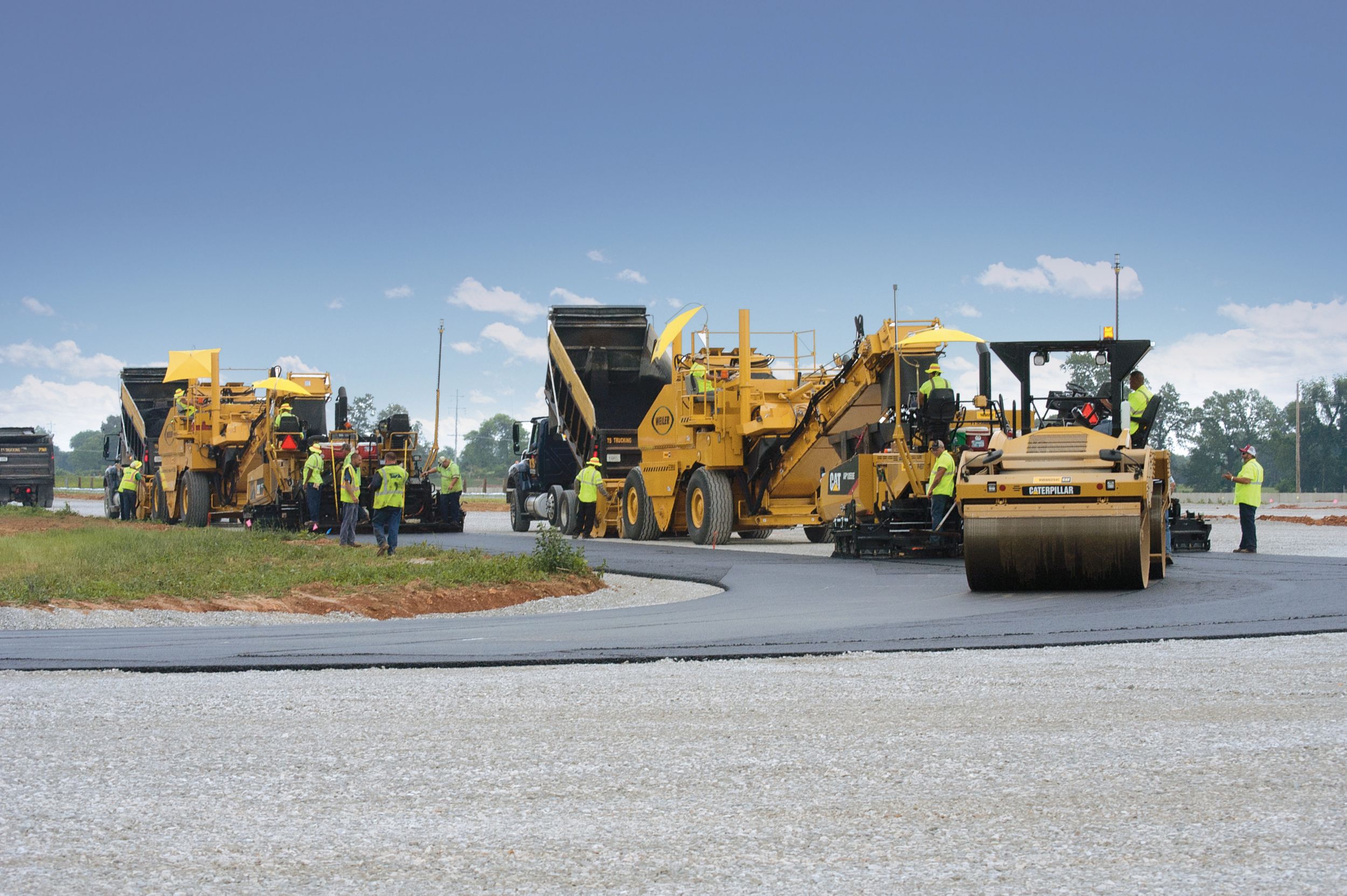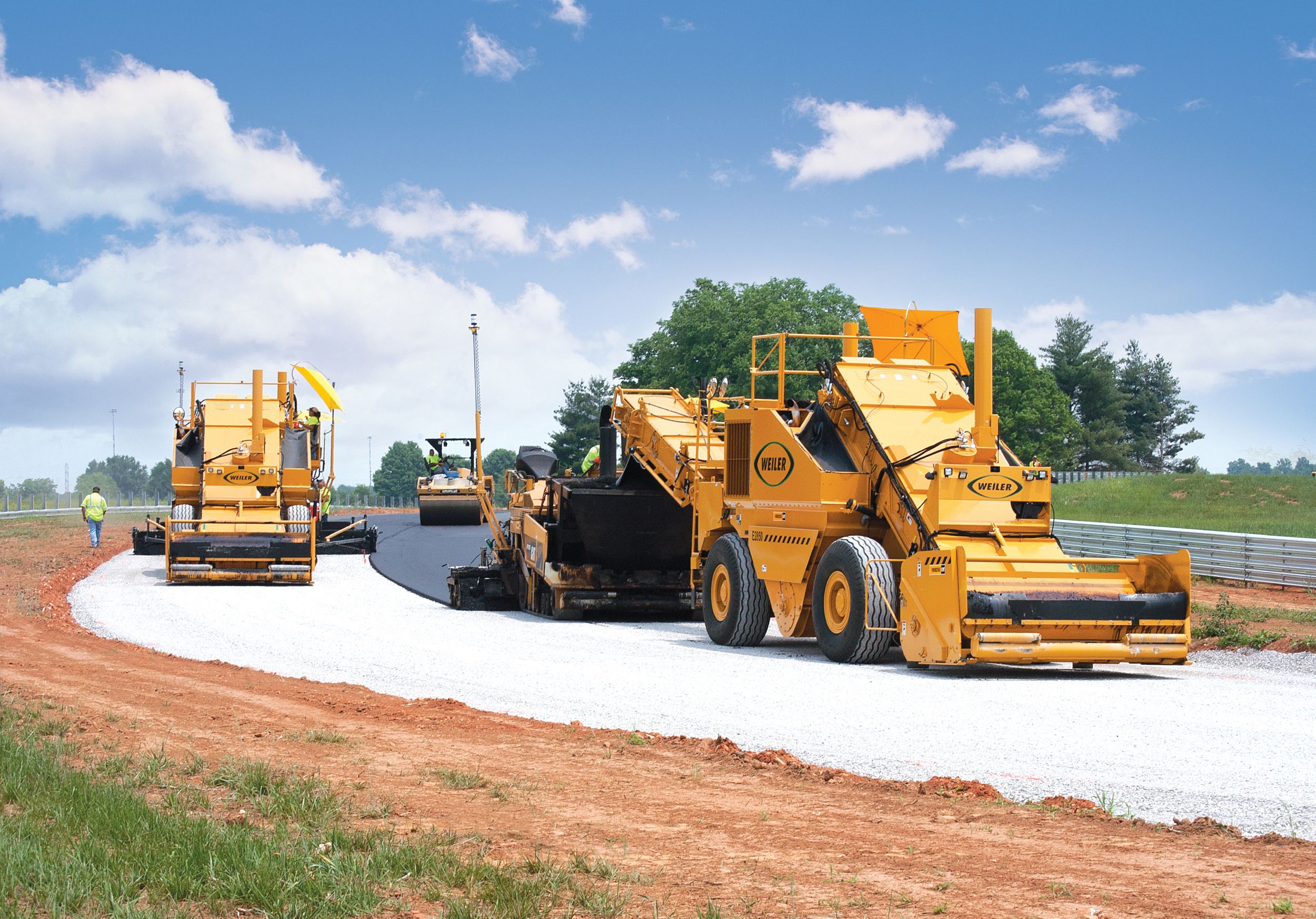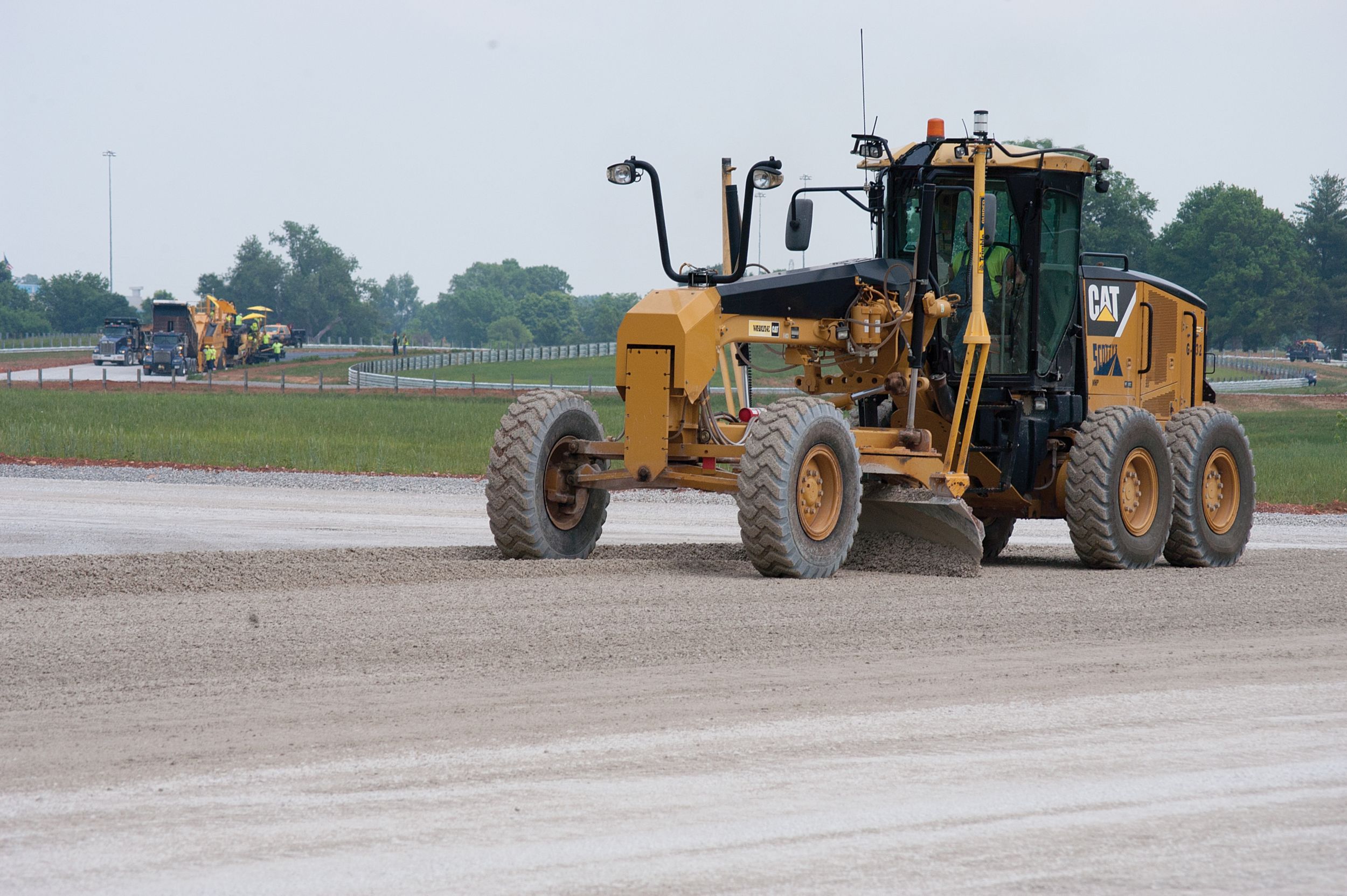The unique design of the National Corvette Museum (NCM) in Bowling Green, Kentucky, caught the eyes of those who travelled Interstate 65 this spring. What didn’t stand out was the land across the interstate—an empty field with a few rolling hills typical of the Kentucky countryside.
Or so it appeared. But that 184-acre field was actually one of the world’s most technologically advanced jobsites. It now is home to the NCM Motorsports Park, which includes a 5.15 km (3.2 mile) road course.
The course requires precise tolerances, and technology helped that happen every inch of the way, from the first pass of a scraper during site preparation to the last roll of a finish compactor.
“During rough grading, the 3D AccuGrade™ dozers worked to within tolerances of tenths of a foot,” says JD Weis, general sales manager with SITECH™ Mid-South, which specializes in the sale of Trimble® products. “Then machines equipped with 3D Total Station based Cat® AccuGrade systems were used to complete the more accurate grading, down to hundredths of a foot. Now we’re coming back with the 3D paving systems and getting the tolerances down to thousandths of a foot.”
The technology was so deeply imbedded that, when museum officials visited the jobsite a few days before work began, they didn’t know where to look.
“They didn’t know where it was—there weren’t any stakes,” says James “Scotty” Scott, CEO and founder of Scotty’s Contracting & Stone, the firm that created the engineering model and handled the site prep and paving.
Scotty’s placed a few stakes so they could get a sense of the course shape. “That’s never happened to us before,” Scotty says.
The Project
The NCM Motorsports Park will serve many purposes. It is a test track for Corvettes, with the Corvette museum and a General Motors factory less than a mile away. It also will be used for various types of driver training, and clubs can rent the track as well.
A race track project requires smoothness, and the NCM park was no exception, with specifications prohibiting deviations of more than 3 mm (1/8 in.) around the track. Another specification required evenness of the longitudinal joint in the center of the course surface too.
“There could not be a cold longitudinal joint,” says Chris Higgins, engineering manager at Scotty’s. That meant two pavers worked in echelon, and the joint was compacted while still hot. “It’s really like there isn’t a joint,” Higgins says.
Also required on the job were material transfer vehicles—in this case Weiler E2850s. The MTVs deliver hot mix without making contact with the pavers, while allowing the pavers to work continuously at a consistent speed. These are crucial benefits on a job with such demanding smoothness specs.
Another smoothness nod was non-stop paving of the track during placement of the surface lift.
“The final day of surfacing on the track consisted of 13 hours of nonstop paving with pavers side by side to eliminate the joint in the track,” says Kenny Reynolds, paving manager at Scotty’s. “The transfer machines and pavers were refueled while they were all moving to eliminate the need for stopping.”
A tight timeframe also proved to be a challenge. Wet weather delayed the start of the project, so technology helped make up for lost time.
“It needed to be done by mid July of this year, and we didn’t start until mid summer of last year,” Higgins says. “Half a million cubic yards of dirt to move, combined with bad weather, made it a tight schedule.”
Most corners of the road course track were sloped at 1.5 percent to 2.5 percent, primarily for drainage and not banking.
While time was a factor, two words—“smoothness” and “precision”—were most frequently spoken.
“Smoothness is key out here,” says Mike Law, vice president of materials for Scotty’s. “Racing at speeds of 180 mph—well, it better be smooth.”
Site Prep
Time pressures were a part of the job, leading to the start of work before all plans were finalized. “The museum wanted to start, but the track wasn’t fully designed, so we did somewhat of a phased construction,” Higgins says.
Scotty’s crews input the job information into Trimble's Business Center software that transforms a design into a 3D site plan. Crews started moving bulk materials in areas they knew would be close to grade, even if final plans weren’t available.
“We used a great deal of machine control,” Higgins says. “With the way the design changes came in, we were constantly modifying the site during the project.”
“WE WOULD JUST MAKE THE CHANGES ON THE SITE PLAN, AND THEY WOULD BE INCORPORATED INTO ALL THE MACHINES.”
The software easily handled revisions to the site plan, which was updated on each machine by way of wireless signals. The changes could be made without a word of communication between Scotty’s central office, the on-site foremen and machine operators. “Those kinds of changes would not have been feasible with staking,” Higgins says. “We had about 15 pieces of automated equipment in here at one time. We would just make the changes on the site plan, and they would be incorporated into all machines.” The machine operators would then work to the updated design.
The project slowed during the depths of winter, though that downtime had been planned and actually improved the quality of the track, says Mitch Wright, general manager of the NCM Motorsports Park.
“We had most of the rough grading done by mid to late November,” Wright says. “That allowed the ground to settle, which over the long run will pay huge dividends. It also helped us find areas that held water. We provided some additional drainage without having to impact the subgrade.”
The GPS and total station controlled the excavators and dozers and made even the rough grading work considerably more precise, a solid start needed to help reach the more precise tolerances later on.
Paving
After rough grading, dense-grade aggregate was laid down to a depth of 22 cm (8.5 in.) using pavers for precise depth and elevation control.
Next came a 64-22 asphalt base course that was compacted to 51 mm (2 in.). “It’s a standard Superpave mix that we use on many jobs,” says Law.
The mix for the next two lifts, each 38 mm (1.5 in.), was a very stiff 82-22 and anything but routine. “We’re topping this off with probably the most premium mix we’ve ever used,” Law says. “The museum worried about tire wear.” Scotty’s consulted with aggregate experts to help find the perfect stone to provide grip and skid resistance.
The liquid asphalt was unique as well. “It’s very highly polymerized,” Law says. “Once we lay this down, it’s going to stay in place for a long, long time.”
Scotty’s developed all the mixes and polymers in their technology center. “It’s something we’re very proud of being able to do,” Law says.
Cat AP1055D and AP1055E Asphalt Pavers laid down the mix. They worked side-by-side to create a hot-on-hot longitudinal joint. The two Weiler E2850s that transferred the mix to the pavers also provided re-mixing for temperature uniformity and elimination of segregation.
The track width is typically 11 m (36 ft.). The lead paver worked at a width of 5 m (16 ft.). The second paver worked closely behind the first paver at a width of 6 m (20 ft.). Average paving speed was about 4.5 m (15 ft.) per minute, based on hourly tonnage, paving depth and paving widths. The relatively low paving speed allowed the pavers to move continuously and not outrun the trucking. That pace also allowed the compactors to match the pavers’ production.
“The pavers are doing just fine working at those widths,” Law says. “The auger is spreading material out. We’ve put extended screeds on there and it’s compacting equally all the way across.”
The 3D Paving Story
Because Scotty’s technology team was used to working with Trimble's Business Center – HCE software, making the step to 3D paving was accomplished seamlessly.
The models automatically generate uncompacted surface designs for the 3D paving system. As the final step in executing the construction of the race course, the designs guide the paver to make adjustments automatically that place slightly more material above low areas and slightly less material in high areas.
“THE BIGGEST BENEFIT OF 3D PAVING IS IT PRECISELY AND ACCURATELY ACHIEVES THE DESIGN, GIVING US THE SMOOTHEST, MOST CONSISTENT SURFACE POSSIBLE.”
The 3D paving system piggybacks on the Cat paver’s conventional 2D grade control system. The design file is stored in the control box installed on the screed. The technology team installed a mast with a prism (target) on top on the right side of the screed. There is also a slope sensor on the bottom of the mast.
Trimble Universal Total Stations (UTS), located strategically around the site, tracked the prisms as the pavers moved around the race course. The Universal Total Stations send a constant stream of signals with precise measurements (accuracy within thousandths of a foot) to the prism on the screed. The prism relays those measurements to the controller where they are compared to the master design file calculations.
If elevation corrections are needed, the commands are sent through the conventional 2D grade control system—to the right tow point in this instance. The left side of the screed is under slope control, using the calibrated slope sensor.
As the pavers move forward, the prism is picked up by the next Trimble Universal Total Station on the jobsite to ensure constant 3D connections. A total of 10 stations were utilized on the site to ensure the paver could make a single long run.
One of the most impressive benefits of the 3D paving system was its ability to use slope control on the joint match side of the trailing paver screed and have consistent height match. This accomplishment underscores the speed, accuracy and inter-connectivity of the Trimble system.
“The biggest benefit of 3D paving is it precisely and accurately achieves the design, giving us the smoothest, most consistent surface possible,” Higgins says.
Compaction
Four Cat® CB64 Vibratory Asphalt Compactors handled breakdown, intermediate and finish phases of compaction. For the breakdown phase, two compactors were set in high amplitude and low frequency. Each roller made four vibratory passes behind its designated paver to achieve 92 percent to 93 percent density.
Because the second paver worked a width of 6 m (20 ft.), the pattern for the second CB64 would require more passes. The quality control technician had the first CB64 drop back and make two passes along the longitudinal joint on the wider side to equalize the patterns and allow both rollers to stay tight to the pavers ahead of the tender zone.
The other two CB64s were set in high frequency and low amplitude for the intermediate phase. They made two vibratory passes behind the tender zone, starting the pattern when the mat was around 80° C (180° F). They dropped back occasionally and made long static passes around 60° C (140° F) for the finish phase. Final density ranged from 94 percent to 95 percent.
Importance of Technology
Higgins says the technology, at all steps of the process, enabled enormous productivity gains. “We never would have finished on time without it.”
The technology also delivered significant cost savings, Scotty says. “On this job, we talk about 3D and GPS, it probably saved us a quarter of a million dollars just on engineering,” he says. “When we save money, that enables us to be cheaper and to win bids, and it really helps our company prosper.”
Monty Boyd, president and chief executive officer of Whayne Supply, the local Cat dealer, says customers such as Scotty help his company prosper, too. “Scotty is one of those customers who is always on the leading edge,” he says. “We’re there trying to help him solve problems and find the solutions he’s looking for to stay ahead of his competition.”
The job was a challenge, yet the Scotty’s crew members wanted to be a part of it, says Reynolds. “The track is beautiful and smooth because the crews were dedicated and wanted to be a part of something that’s going to be successful for a long time.”
Is the job a success? Reynolds says only the customer, Wright, can answer that question. His reply is an unqualified “yes.”
“I believe we’re going to be the envy of the industry with the surface we have,” Wright says.
Learn more about the track at motorsportspark.org.


